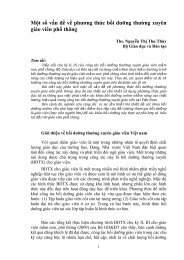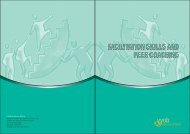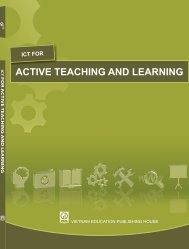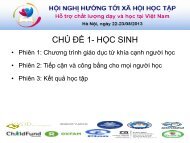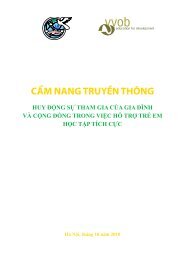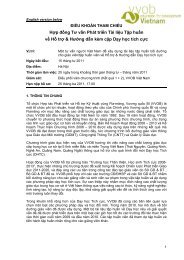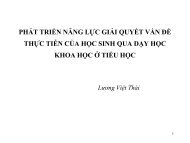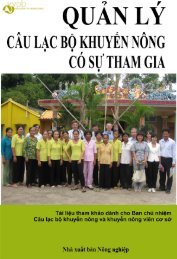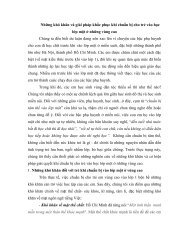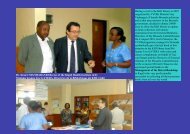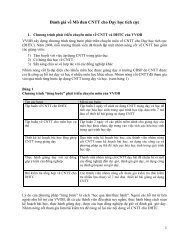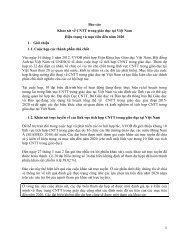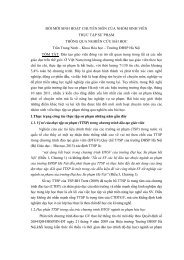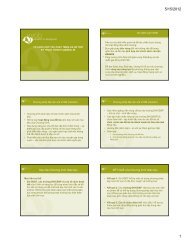Kenya Multi-Year Programme 2011-2013 - VVOB
Kenya Multi-Year Programme 2011-2013 - VVOB
Kenya Multi-Year Programme 2011-2013 - VVOB
- No tags were found...
Create successful ePaper yourself
Turn your PDF publications into a flip-book with our unique Google optimized e-Paper software.
6.4.3.7. Intervention logicThe Healthy Learning programme intervention logics have been designed by selecting majorinterventions that are most likely to be effective in achieving the specific objective that the MOE hasdeveloped and implements sustainable strategies for an integrated ―Healthy Learning‖ approach inbasic education with special attention to the poorest and most vulnerable children in disadvantagedareas. This is part of a broader National Strategy on School Health, Nutrition and Meals, of which adraft was already developed in Phase I of Healthy Learning. To achieve this specific objective, five keyintermediate results which MOE will deliver have been identified:IR 1: Ministry of Education staff involved in the Investment <strong>Programme</strong> ―School Health, Nutrition &Meals‖ of the <strong>Kenya</strong> Education Sector Support <strong>Programme</strong> (KESSP) coordinates, harmonizes,advises on and supports initiatives promoting ―Healthy Learning‖.IR 2: Schools in disadvantaged areas are applying multi-disciplinary methods of life skillsdevelopment for improved learning, nutrition and health to the benefit of poor and vulnerablechildren, their families and communities.IR 3: The Ministry of Education has integrated approaches and lessons learned from HealthyLearning in teacher support activities related to school health, nutrition and meals.IR 4: Healthy Learning programme partners ensure the documentation and sharing of ―lessonslearned‖ with relevant stakeholders.The fifth result area relates to the management and coordination of the programme by <strong>VVOB</strong>:IR 5: The programme is enabled to remain relevant and sustainable by developing organisationalpractices that focus on learning and accountability by the cooperating partners.Within each of these intermediate results, several subresults have been identified which the HealthyLearning programme will achieve as contribution to the intermediate result of MOE.At national level (IR 1), the Healthy Learning programme facilitates capacity strengthening of Ministryof Education key staff in emerging and new areas related to the ‗expansion‘ and sustainability of theprogramme. Expansion is seen as as the integration of Healthy Learning concepts in otherprogrammes (e.g. home-grown school meals programmes) through avenues of policy implementation,such as the National Strategy for School Health, Nutrition and Meals.At the district and school levels (IR 2), the Healthy Learning programme will be involved lessintensively in Phase II as compared to Phase I, with a view of gradually giving more responsibility tothe 8 districts and 30 schools to ensure continuity as well as outreach to more schools and districts.Focus will be on capacity strengthening of districts and schools for impact and sustainability. HealthyLearning model districts and model schools will be sharing their approaches, stories, and successeswith other districts and schools more actively than before.In terms of teacher support (IR 3), the Healthy Learning programme will ensure that a HealthyLearning teacher support module and assessment mechanism are available and promoted by theMinistry of Education. Other partners and stakeholders will be able to make use of the HealthyLearning materials in other geographical areas and programmes.Within the area of documentation and sharing of ―lessons learned‖ (IR 4), internal reflection andmonitoring will done on a regular basis for strengthening effectiveness, efficiency and sustainability ofthe Healthy Learning programme. Experiences will be shared with other relevant programmes within<strong>Kenya</strong> and elsewhere where relevant. Specific Healthy Learning issues willl be supported by focusedresearch.Like other <strong>VVOB</strong> programmes, Healthy Learning also supports organisational learning within <strong>VVOB</strong>(IR 5).It‘s also important to note that the five intermediate results are all interlinked. Interventions at theschool and district level (IR 2) provide a proof of concept which feeds into initiatives at national level(IR 1) as well as broader teacher support activities (IR 3) (bottom-up approach). On the other hand,involvement at the national level (IR 1) ensures that Healthy Learning will have an impact on schools<strong>Kenya</strong> - <strong>Multi</strong>-<strong>Year</strong> <strong>Programme</strong> <strong>2011</strong>-<strong>2013</strong> 64/148



